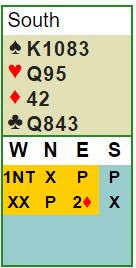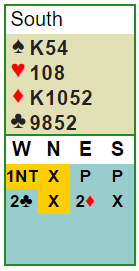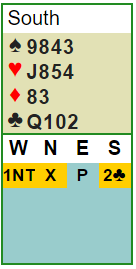 Source: Taming the Weak Notrump, part 1 By Steve Weinstein and Adam Kaplan Feb. 7, 2013
Source: Taming the Weak Notrump, part 1 By Steve Weinstein and Adam Kaplan Feb. 7, 2013

The weak NT is a powerful convention that is difficult to play against. Weak NTs can wreak havoc on even the most experienced partnerships. They cause volatility on “normal” hands, serve as effective pre-empts, and defending against them is often misunderstood. We are more likely to have a game after the opponents open a weak NT, than if they open a strong NT. As a result, our objectives and criteria for entering the auction are different.
Competing over a weak NT can be dangerous, because the opponents have already narrowly defined one of their hands, and we are completely in the dark about partner’s strength and distribution. If they misstep, it is much harder for us to penalize them; however, if we misstep, it’s easy for them to penalize us because they already know so much more about their side’s values and shape. We are trying to make the best educated guesses possible, but they are a step ahead because of the descriptive nature of their opening bid.
In this article, our focus is on auctions that start with Double by the non-opening side. We cover the objectives for doubling, and then we present a structure for competing after the initial Double. We define a weak NT opening as having a minimum of a good 13 or less. If their card says 14-16, we consider it strong, but if their card says 13+-16, we consider it weak. As we work through examples, for ease of visualization, we assume that the dealer opens the bidding with 1NT; thus, 3rd seat is always the “responder,» and 4th seat is always the player to the right of the 1NT opener.
Objectives for Doubling 1NT
1. Establish that it’s our hand.
2. Penalize the opponents.
3. Compete for part-scores.
4. Judge when to bid a game, and when to stop in a part-score.
5. Avoid going for a number while accomplishing the above four goals.
Accomplishing our objectives
Double provides the backbone for many of the above objectives, but it is also the most challenging call to untangle, since it includes so many hand-types. We need Double to convey our values, penalize them, and establish a foundation for competition. A combination of card-showing and takeout doubles, along with Lebensohl, allows us to not only compete accurately, but also judge whether to bid game or stop in a part-score.
All of the above objectives apply when bidding in 4th seat as well, but in 4th seat, RHO has often already described their hand-type. Although we sometimes have less bidding space, we have more information to work with.
When we Double their NT in 2nd seat (directly)
The hand-types included in Double vary slightly depending on your other methods over 1NT; we choose to define a penalty double as 15+ HCP. We double on almost every 15+ HCP hand without a 6-card suit, balanced or not. (Whether to double or overcall with a 6-card suit and 15+ HCP depends greatly on your methods and is beyond the scope of this article.) Depending on your preferences, or if you are playing against a 10-12 NT, you can adjust the expected range for double accordingly.
Methods after 2nd hand’s Penalty Double
When 3rd Hand Passes over the Double
We now define the bids of the advancer (the partner of the doubler) when responder (3rd hand) passes. Most weak notrump systems have intricate runout structures that assign special meanings to 3rd hand’s pass. Although there are small gains from playing different methods based on these specific meanings, in the case of pass, these gains are negligible when considering the amount of memory work necessary. Using the same structure vs. pass, no matter what it means, works well enough in practice.
After 3rd hand’s pass, advancer (4th hand) should pull to the 2-level with very weak hands (generally 0-4 HCP), pull to 2NT and higher with strong (game-forcing) offensive hands, and pass holding 5+ HCP and no clear direction. We recommend playing a natural structure instead of “systems on,” since the doubler is not always balanced, and may have a difficult time showing their hand with a “systems on” approach.
PASS shows 5+ HCP, and sets up a force through 2 (the opponents cannot play a contract of 2
(the opponents cannot play a contract of 2 or lower undoubled). If advancer passes and then bids at the 2-level on a later round, this is natural and non-forcing. Doubler’s later non-jumps are also natural and non-forcing; he must cue-bid or jump to force. After passing, the first double by our side of a natural suit is takeout, and later doubles are penalty.
or lower undoubled). If advancer passes and then bids at the 2-level on a later round, this is natural and non-forcing. Doubler’s later non-jumps are also natural and non-forcing; he must cue-bid or jump to force. After passing, the first double by our side of a natural suit is takeout, and later doubles are penalty.
 Since this would be the first double by our side after the penalty double, and their bid is natural, our Double is takeout. If 2
Since this would be the first double by our side after the penalty double, and their bid is natural, our Double is takeout. If 2 were artificial (say, the majors), then Double shows cards.
were artificial (say, the majors), then Double shows cards.

Our side has already used our takeout double, now all our doubles are penalty. Doubling 2 here shows 4+ cards in their suit.
here shows 4+ cards in their suit.
2 is a general-purpose pull with weakness (0-4 HCP), and could be a balanced weak scramble. It cannot contain a 5-card suit other than clubs. We try to have at least 2 clubs for this call — with the dreaded 4441 pattern we would probably bid 2
is a general-purpose pull with weakness (0-4 HCP), and could be a balanced weak scramble. It cannot contain a 5-card suit other than clubs. We try to have at least 2 clubs for this call — with the dreaded 4441 pattern we would probably bid 2 . After 2
. After 2 , the doubler is expected to pull with a 5-card suit of their own, or if they have no 5-card suit and fewer than 4 clubs, they pull to their lowest 4-card suit. Our goal is to find a playable spot and avoid too much damage, not find the perfect contract.
, the doubler is expected to pull with a 5-card suit of their own, or if they have no 5-card suit and fewer than 4 clubs, they pull to their lowest 4-card suit. Our goal is to find a playable spot and avoid too much damage, not find the perfect contract.

With below our suggested minimum to pass and no 5-card suit, we leave our options open for finding a safe playing spot by bidding 2 to show our general weakness. This bid does not promise clubs, it just shows the lack of a biddable 5-card suit.
to show our general weakness. This bid does not promise clubs, it just shows the lack of a biddable 5-card suit.
2 , 2
, 2 , and 2
, and 2 show 5+ card suits (2
show 5+ card suits (2 could be 4441) and weak hands (0-4 HCP). Further followups are natural, and we are not in a force.
could be 4441) and weak hands (0-4 HCP). Further followups are natural, and we are not in a force.
2NT shows a forcing 2-suiter with at least 5-5 in the two suits: Enough values to game-force, but too offensive to defend 1NT-X. After 2NT, the doubler bids the lowest suit for which they have at least 3-card support. Since a game-force has been established, we still have room to find a better fit if possible. Doubler’s 3 bid is natural, showing at least 5.
bid is natural, showing at least 5. We showed diamonds and a major with 3
We showed diamonds and a major with 3 (if we had clubs and diamonds, we would have raised). Since reaching a major-suit fit takes priority over a minor-suit fit, partner’s 3
(if we had clubs and diamonds, we would have raised). Since reaching a major-suit fit takes priority over a minor-suit fit, partner’s 3 shows 3+ hearts and does not deny 3+ diamonds (which can be shown later). Now, we can show our major with 3
shows 3+ hearts and does not deny 3+ diamonds (which can be shown later). Now, we can show our major with 3 .
.

When we hold clubs and a major and partner bids 3 , we still bid our major because it’s important to find the major-suit fit. Unlike the previous example, this 3
, we still bid our major because it’s important to find the major-suit fit. Unlike the previous example, this 3 bid does not deny a club fit. We would bid the same way with both majors or with hearts + clubs.
bid does not deny a club fit. We would bid the same way with both majors or with hearts + clubs.
3 of a new suit is natural and game-forcing: Enough values to game-force, but too offensive to be willing to defend 1NT-X
At unfavorable vulnerability, this is a clear 3 bid. It’s possible 1NT-X may not be enough to make up for your practically certain game.
bid. It’s possible 1NT-X may not be enough to make up for your practically certain game.
When 3rd hand redoubles
For simplicity, we recommend using the same structure as if they had passed over the double. It doesn’t matter if the redouble shows values or is the start of a runout. When in doubt, if the redouble shows values, prefer running out to potentially sitting out 1NT redoubled.
Summary of methods to date:
1NT (Double) = 15+ HCP, could be unbalanced
- 3rd hand passes or redoubles
- PASS = no clear direction, 5+ HCP, sets up forcing pass through 2

- first double of natural bid becomes takeout
- 2
 = ART, 0-4 HCP, no 5-card spade/heart/diamond suit
= ART, 0-4 HCP, no 5-card spade/heart/diamond suit
- With 0-3 clubs, doubler should pull to a 5-card suit, or their cheapest 4-card suit.
- 2
 = natural, 5+ diamonds, 0-4 HCP
= natural, 5+ diamonds, 0-4 HCP - 2
 = natural, 5+ hearts, 0-4 HCP
= natural, 5+ hearts, 0-4 HCP - 2
 = natural, 5+ spades, 0-4 HCP
= natural, 5+ spades, 0-4 HCP - 2NT = ART, GF two-suiter (5-5 or better)
- Doubler bids 3-card suits up the line, or 3
 to show long spades
to show long spades
- Doubler bids 3-card suits up the line, or 3
- 3 any = natural, GF one-suiter
- PASS = no clear direction, 5+ HCP, sets up forcing pass through 2
In part 2 of Taming the Weak NT, we will cover the structure after 3rd hand bids over 2nd hand’s penalty double, and when 4th hand is the initial doubler.
